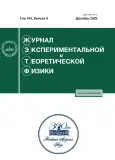Interatomic Interaction at the Al–TiC Interface
- Autores: Reshetnyak V.V.1,2,3, Aborkin A.V.3, Filippov A.V.1,2
-
Afiliações:
- Troitsk Institute for Innovation and Fusion Research
- Joint Institute for High Temperatures, Russian Academy of Sciences
- Vladimir State University
- Edição: Volume 164, Nº 6 (2023)
- Páginas: 996-1007
- Seção: Articles
- URL: https://journals.rcsi.science/0044-4510/article/view/247364
- DOI: https://doi.org/10.31857/S0044451023120131
- EDN: https://elibrary.ru/MXVJUP
- ID: 247364
Citar
Texto integral
Resumo
The interaction of a titanium carbide nanoparticle with aluminum (100), (110), and (111) substrates is investigated within the density functional theory. The nanoparticle–substrate interaction energies are determined; the electron density distribution and the electron localization function between aluminum, titanium, and carbon atoms are analyzed. It has been established that the atoms in the upper layers of the aluminum (100) and (110) substrates are significantly displaced relative to their initial positions as a result of the interaction with the nanoparticle, whereas a minor displacement of atoms is typical for the (111) substrate. The interaction between aluminum and carbon atoms at the Al–TiC interface is due to the formation of covalent Al–C chemical bonds. The aluminum atoms forming carbide bonds do not form chemical bonds with titanium atoms. The aluminum atoms that are adjacent to the titanium atoms and are not involved in the formation of carbide bonds form metallic Al–Ti bonds.
Sobre autores
V. Reshetnyak
Troitsk Institute for Innovation and Fusion Research;Joint Institute for High Temperatures, Russian Academy of Sciences; Vladimir State University
Email: viktor.reshetnyak84@gmail.com
108840, Troitsk, Moscow, Russia; 125412, Moscow, Russia; 600000, Vladimir, Russia
A. Aborkin
Vladimir State University
Email: viktor.reshetnyak84@gmail.com
600000, Vladimir, Russia
A. Filippov
Troitsk Institute for Innovation and Fusion Research;Joint Institute for High Temperatures, Russian Academy of Sciences
Autor responsável pela correspondência
Email: viktor.reshetnyak84@gmail.com
108840, Troitsk, Moscow, Russia; 125412, Moscow, Russia
Bibliografia
- I.A. Evdokimov, T.A. Chernyshova, G.I. Pivovarov, P.A. Bykov, L.A. Ivanov, and V.E. Vaganov, Inorg. Mater. Appl. Res. 5, 255 (2014).
- R. Casati and M. Vedani, Metals 4, 65 (2014).
- A.V. Aborkin, D.V. Bokaryov, S.A. Pankratov, and A.I. Elkin, Ceramics 6, 231 (2023).
- A.V. Aborkin, A.I. Elkin, V.V. Reshetniak, A.M. Ob'edkov, A.E. Sytschev, V.G. Leontiev, D.D. Titov, and M.I. Alymov, J. Alloys.Comp. 872, 159593 (2021).
- S.L. Pramod, S.R. Bakshi, and B.S. Murty, J. Mater. Eng. Perform. 24, 2185 (2015).
- P. Sharma and S. Ganti, Phys. Stat. Sol. B 234, R10 (2002).
- P. Sharma, S. Ganti, and N. Bhate, Appl. Phys. Lett. 82, 535 (2003).
- H.L. Duan, J. Wang, Z.P. Huang, and B.L. Karihaloo, J. Mech. Phys. Sol. 53, 1574 (2005).
- В.Е. Панин, Е.Е. Дерюгин, С.Н. Кульков, Прикл. мех. техн. физ. 51(4), 127 (2010).
- Дж. Роулинсон, Б. Уидом, Молекулярная теория капиллярности, Мир, Москва (1986).
- V. Reshetniak, O. Reshetniak, A. Aborkin, V. Nederkin, and A. Filippov, Nanomaterials 12, 2045 (2022).
- W.J. Kim and Y.J. Yu, Scripta Mater. 72-73, 25 (2014).
- W. Liu, C. Cao, J. Xu, X. Wang, and X. Li, Mater. Lett. 185, 392 (2016).
- В. И. Ролдугин, Физикохимия поверхности, Изд. дом <Интеллект>, Долгопрудный (2011).
- A.H. Larsen, J.J. Mortensen, J. Blomqvist et al., J. Phys. Condens. Matter 29, 273002 (2017).
- T.D. Ku¨hne, M. Iannuzzi, M. Del Ben et al., J. Chem. Phys. 152, 194103 (2020).
- J. P. Perdew, K. Burke, and M. Ernzerhof, Phys. Rev. Lett. 77, 3865 (1996).
- S. Goedecker, M. Teter, and J. Hutter, Phys. Rev. B 54, 1703 (1996).
- J. VandeVondele and J. Hutter, J. Chem. Phys. 127, 114105 (2007).
- G. Lippert, J. Hutter, and M. Parrinello, Mol. Phys. 92, 477 (1997).
- G. Lippert, J. Hutter, and M. Parrinello, Theor. Chem. Acc. 103, 124 (1999).
- A. V. Chichagov, V. A. Varlamov, R. A. Dilanyan, T. N. Dokina, N. A. Drozhzhina, O. L. Samokhvalova, and T. V. Ushakovskaya, Crystallogr. Rep. 46, 876 (2001).
- Дж. Най, Физические свойства кристаллов и их описание при помощи тензоров и матриц, Мир, Москва (1967).
- И. Н. Францевич, Упругие постоянные и модули упругости металлов и неметаллов, Наук. думка, Киев (1982).
- J. Sch¨ochlin, K. P. Bohnen, and K. M. Ho, Surf. Sci. 324, 113 (1995).
- N. E. Singh-Miller and N. Marzari, Phys. Rev. B 80, 235407 (2009).
- W. Tyson and W. Miller, Surf. Sci. 62, 267 (1977).
- L. H. Fang, L. Wang, J. H. Gong, H. S. Dai, and D. Zh. Miao, Transactions of Nonferrous Metals Society of China 20, 857 (2010).
- A. Vojvodic, C.Ruberto, and B. I. Lundqvist, J. Phys. Condens. Matter 22, 375504 (2010).
- M. G. Quesne, A. Roldan, N. H. de Leeuw, and C. R. A. Catlow, Phys. Chem. Chem. Phys. 20, 6905 (2018).
- L. Wang, L. H. Fang, and J. H. Gong, Transactions of Nonferrous Metals Society of China 22, 170 (2012).
- L. M. Liu, S. Q. Wang, and H. Q. Ye, J. Phys. Condens. Matter 15, 8103 (2003).
- E. A. Aguilar, C. A. Leon, A. Contreras, V. H. Lopez, R. A. L. Drew, and E. Bedolla, Composites, Part A 33, 1425 (2002).
- C. A. Leon, V. H. Lopez, E. Bedolla, and R. A. L. Drew, J. Mater. Sci. 37, 3509 (2002).
- A. Contreras, J. Colloid Interface Sci. 311, 159 (2007).
- Р. Бейдер, Атомы в молекулах: квантовая теория, Мир, Москва (2001).
- B. Silvi, I. Fourr'e, and M. E. Alikhani, Monatshefte fu¨r Chemie 136, 855 (2005).
- Е. В. Барташевич, В. Г. Цирельсон, Успехи химии 83, 1181 (2014).
- A. D. Becke and K. E. Edgecombe, J. Chem. Phys. 92, 5397 (1990).
- B. Silvi and A. Savin, Nature 371, 683 (1994).
- В. Г. Цирельсон, Квантовая химия. Молекулы, молекулярные системы и твердые тела, БИНОМ, Лаборатория знаний, Москва (2010).
- D. Stalke, Electron Density and Chemical Bonding I: Experimental Charge Density Studies, Springer, Berlin (2012).
- B. Silvi and C. Gatti, J. Phys. Chem. A 104, 947 (2000).
Arquivos suplementares









